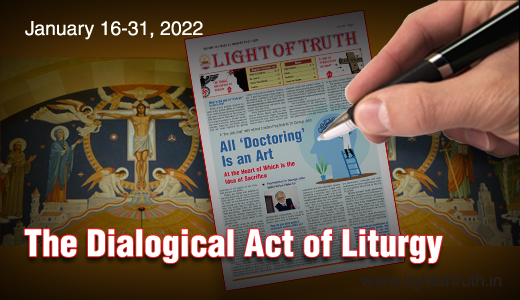Azadi ka Amrit Mahotsav Kolkata event honours four Clergymen
Pope Francis asks businesses to support working women: They’re ‘afraid to get pregnant’
Study: Christianity may lose majority, plurality status in U.S. by 2070
Indian politician declines Magsaysay Award under party pressure
Like John Paul II, Pope Francis heads to Kazakhstan during time of war

The decision to have the liturgy in vernacular was a very revolutionary idea that has not yet been properly understood. The conciliar intent of the reform of liturgy is to “express more clearly the holy things they signify.” When this expressive purpose is transposed into practical consequences for celebration by the Christian community, it suggests a specific form: the texts should be “marked by a noble simplicity; they should be short, clear, and unencumbered by useless repetitions; they should be within the people’s powers of comprehension and as a rule not require much explanation. This is so that the community may understand and participate in the liturgy fully and actively.” The liturgical speech acts of the Lord’s Supper constitute anamnesis for worshipers.
The text of the celebration is dead letter, but it the celebrant and the community who bring it alive. A sentence in the text can have different meanings, depending on the intonation of the recitation; mimic and gesture compliment and provide nuances, often contrary to what is usually expected. Here it is the very person of the celebrant that acts out his faith, his gestures, his unction and mode, which are all revelatory to the sacred mystery he enacts sacramentally. The celebrant’s activity becomes the activity of expressed valuation, which colours all aspects of the word: the word abuses, caresses, is indifferent, denigrates, embellishes, etc. Under the intonative aspect of the word, we understand its capacity to express all the diversity of the speaker’s axiological attitudes toward the content of an utterance on the psychological plane—the diversity of the speaker’s emotional-volitional reactions. The wealth and diversity of speech genres are boundless, because the various possibilities of human activity are inexhaustible and each sphere of activity contains an entire repertoire of speech genres that differentiate and grow as the particular sphere develops and becomes more complex. It is not a solitary act. This can happen only in the face-to-face situation of the congregation. The orientation is the key. When the celebrant is away and behind the people, it will substantially affect the dialogical aspect of the celebration. There is no dialogue possible in processional mode or towards the back. This indicates a sensitivity to the communicative value of the liturgical text, to the value of the different parts of the rite, Jesus’s original command focused on the anamnestic character of doing the Lord’s Supper—“Do this in remembrance.” In a language that supports the terminology for liturgical speech act, we can define anamnesis as “nothing less than the ‘re-calling’ or ‘re-presentation’ of the passion of Christ so that ‘it becomes here and now operative by its effects in the communicants.” Representative acts, which make present again and bring into being a state of affairs, have anamnestic capacity. Language becomes key to this anamnesis. It comes to life and act in the community. “For the word is not a material thing but rather the eternally mobile, eternally fickle medium of dialogic interaction,” wrote Mikhail Bakhtin. Our anamnetic performance consists of seeing, touching, and receiving the body and blood, while the Holy Spirit joins the embodied signum to the res of Christ’s body and blood. The Holy Spirit brings the perlocutionary effect of a transforming encounter with Jesus Christ in the heavenlies and we are truly changed through our sacramental participation—whether it be comforted, given hope, a renewed energy to obey, or the profoundly deep knowledge that Christ suffered for us, because God loves us and we are therefore truly adopted children of the Father.
In Introduction to Christianity, then Cardinal Ratzinger identifies the ‘definitive distinguishing mark of man ‘as the reality that man is ‘God’s partner in dialogue’. He expounds this idea in recognizing that ‘having a spiritual soul’ means ‘being a creature called by God to an eternal dialogue and therefore capable for its own part of knowing God and of replying to him’. He wrote “God who is not only logos but also dialogos.” Revelation properly understood is essentially a dialogue that unfolds in history between God and humanity. “No revelation has occurred, because no veil has been removed”. By definition, revelation requires someone who apprehends it. Revelation “seen basically as dialogue”. What makes dialogue work is the process it calls for: the participants are asked to enter in humility and stay in patience, willingly agreeing to their own vulnerability, rejecting their own pride; the participants maintain their voices while joining in one conversation and allowing their shared vocalized interaction to influence their interior opinions; and the participants are invited to engage in charity as they come to witness to the other person and express their care dialogically. There can be no such thing as an absolutely neutral utterance. The expressive aspect has varying significance and varying degrees of force in various spheres of speech communication, so it exists also in liturgy. The dialogue at once God’s prayer to the people of God and the church prayer to her Lord. It is a call and a response face to face.
Leave a Comment